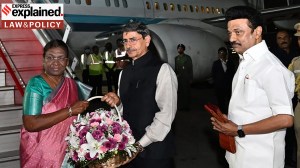US for Indian troops in Kurd zone
New Delhi is grappling with the politicaly vexed issue of sending ‘‘stabilisation force’’ to Baghdad even as the US has ...

New Delhi is grappling with the politicaly vexed issue of sending ‘‘stabilisation force’’ to Baghdad even as the US has formally indicated that it wants Indian Army troops in the Kurdish sector in Northern Iraq.
On the directions of the Cabinet Committee on Security meeting on May 26, the security establishment, after discussing the latest UN Security Council Resolution 1483, has come up with a series of options that makes the Iraq force option politically palatable. These options try to address the following questions posed by the CCS: Is there a UN mandate for the stablisation force? Under whose command will the Indian troops operate? And will Indians will be asked to fire on Iraqis to quell a law and order situation?
The security establishment here sees the UN mandate for the “force” in the operative paragraph one of resolution 1483, which appeals to member-states and not coalition partners to “contribute to conditions of stability and security in Iraq.” This means that, by sending troops to Iraq, India is answering to the UN appeal and not to the “authority” that is US and UK.
On the command and control structure, the broad thinking here is that the UN should impress upon the authority to look into the concept of rotational command. This means that establishment of a joint command structure between the sector commanders and the American Central Command headed by General Tommy Franks. It is felt that the joint command should be headed by a two-star general or officer of the rank of major-general, with the post being rotated among those countries contributing to the stabilisation force.
The logic is that a commander will be in charge of his troops in the clearly demarcated sectors following proper rules of engagement. However, he will be in touch with the joint command that will translate the authority’s action on the ground.
But South Block still does not have clear-cut answers to whether Indian troops will have to fire on Iraqis to quell the law and order situation. It was mainly this question that held back the CCS decision on sending troops to Iraq.
However, the outcome of discussions in the South Block indicates that chances of Indian troops firing on Iraqis are very limited, particularly when the deployment is going to be in Kurdish sector of Northern Iraq.
India has a long-standing engagement with the Kurds, who are semantically of a different stock than the Arabs and Jews in West Asia. After the enforcement of a no-fly-zone in northern Iraq, the Kurdish Patriotic Union of Jalal Talabani and Kurdish Democratic Party of Masood Barzani have been in control of these areas.
The two parties have been sharing the oil revenues from fields between cities of Kirkuk and Mosul in Northern Iraq and thus have little incentive in provoking the local populace against the Indian troops. All the same, if New Delhi were to send a troop division to Northern Iraq then it will have to deal with militants elements of Kurdistan Workers’ Party (PKK) led by Abdullah Ocalan and assuage the security concerns of neighbouring Turkey.
Ankara has serious concerns over Kurdish spill-over to its territory and has posted no less than 60 observers in Kirkuk and Mosul to keep a watch on the situation.
The Indian Army has already identified the battalions which will form a division (around 10,000 troops) for Iraq. While none of these battalions will be pulled out from Jammu and Kashmir, they will have a strong element of engineers and doctors in order to make themselves dear to the Iraqi people. But like the South Block, the Army needs a green signal before it moves into Iraq.
Photos


- 01
- 02
- 03
- 04
- 05





























